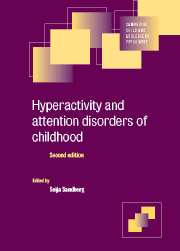Book contents
- Frontmatter
- Contents
- List of contributors
- Preface
- 1 Historical Development
- 2 Epidemiological aspects: what have we learned over the last decade?
- 3 Cross–cultural/ ethnic aspects of childhood hyperactivity
- 4 4 Sex differences and their significance
- 5 Classification issues
- 6 The role of attention
- 7 Cognitive aspects and learning
- 8 Developmental perspectives
- 9 Behavioural and molecular genetic studies
- 10 Biological underpinnings of ADHD
- 11 Psychosocial contributions
- 12 Institutional care as a risk factor for inattention/overactivity
- 13 Treatments: The case of the MTA study
- 14 Attention feficit hyperactivity disorder in adults
- Index
7 - Cognitive aspects and learning
Published online by Cambridge University Press: 28 August 2009
- Frontmatter
- Contents
- List of contributors
- Preface
- 1 Historical Development
- 2 Epidemiological aspects: what have we learned over the last decade?
- 3 Cross–cultural/ ethnic aspects of childhood hyperactivity
- 4 4 Sex differences and their significance
- 5 Classification issues
- 6 The role of attention
- 7 Cognitive aspects and learning
- 8 Developmental perspectives
- 9 Behavioural and molecular genetic studies
- 10 Biological underpinnings of ADHD
- 11 Psychosocial contributions
- 12 Institutional care as a risk factor for inattention/overactivity
- 13 Treatments: The case of the MTA study
- 14 Attention feficit hyperactivity disorder in adults
- Index
Summary
The psychopathology of attention deficit hyperactivity disorder (ADHD) consists of the behavioural symptoms of inattention, overactivity and impulsiveness, is well recognized in children and adolescents, and is reported as one of the most frequently seen problems in child psychiatry (Toone and Van der Linden, 1997; Taylor, 1998). However, there is significant heterogeneity among individuals presenting with behavioural problems of inattention, overactivity and impulsiveness. Different diagnostic traditions have evolved different conceptualizations of the essential features associated with such behaviour by both clinicians and researchers (Ostrander et al., 1998). Heterogeneity between individuals and diagnostic classification systems contributes to much of the conflicting evidence over the cognitive functioning or dysfunctioning in ADHD. The main diagnostic classifications for such psychopathology are: • Attention deficit hyperactivity disorder (ADHD) in the Diagnostic and Statistical Manual of Mental Disorders (DSM-IV) by the American Psychiatric Association (APA: American Psychiatric Association, 1994) • Hyperkinetic disorder (HKD) in the International Classification of Mental and Behavioural Disorders (ICD-10) by the World Health Organization (WHO: World Health Organization, 1993). Until recently, the classification of childhood psychopathology of hyperactivity by the APA and WHO differed in three key respects – the symptoms they emphasized, the importance they placed on symptom pervasiveness and their treatment of comorbid disorders (Tripp et al., 1999). However, the fourth edition of the DSM (APA, 1994) brought the APA and WHO systems for classifying childhood hyperactivity closer (Tripp et al., 1999).
- Type
- Chapter
- Information
- Hyperactivity and Attention Disorders of Childhood , pp. 214 - 241Publisher: Cambridge University PressPrint publication year: 2002

